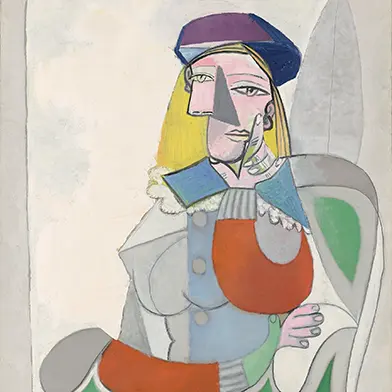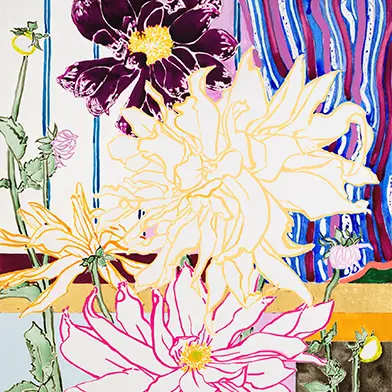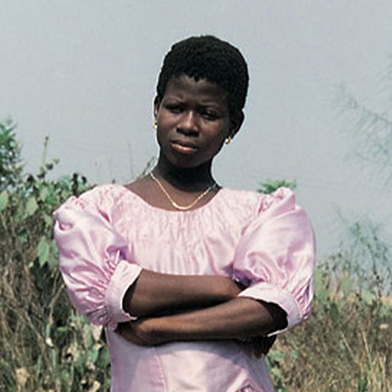Julia Haft-Candell: What should we call the show?
J.A Feng: The first thing that comes to mind with my new work, and your work, is pattern.
JHC: Yes, I especially like the idea of inventing patterns. Throughout history people have been using patterns in this very innocuous, yet often political way. I remember our conversation about your ideas of pattern in your new painting that shows several repeated hands grasping at a salmon fish.
JF: That painting incorporates a grid. The phenomenon that I'm trying to illustrate with the painting is that of moving goalposts–where the thing that you're trying to grasp is a little bit out of reach. That's why the hands get smaller, and the fish get bigger in the painting.[1]
JHC: We could call the show reach/grasp? Interlocking hands is a recurring theme in my work too.
JF: Yes. That describes that painting–and the show.
JHC: When I saw an early version of that painting you said something about a vector.
JF: There’s an X and Y axis. And then there's a plot point for where each hand is grabbing a fish, and I'm planning to draw a line to show the correlation between reach versus grasp.
JHC: Right, I remember now. The way that you talk about that painting using geometry terms–it is unexpected and super interesting.
JF: It's fun. It's different. I don't know if this is the proper term, but I was thinking about an “inflection point”–when things turn and do the opposite. So, there is one hand where it is catching the fish. The hand can hold on to it and it's the optimal size that it can catch. And then progressively, the fish get too big, and the hand gets too small. I’m interested in that threshold, from where it's working to where there is an imbalance.
JHC: I love that metaphor and how it relates to reaching versus grasping and diffusing ideas of binary. Because there's this or that, and then the inflection point is something in the middle–the fine line or the gray area or the in-between. It’s also interesting in terms of dispelling an idea of balance. If there is an inflection point, I don't believe you can ever truly be at that point or secure a balance. You either are at it and then over to one side, or you're over to the other side: you’re constantly moving through that point.
JF: For sure. Things feel so in flux constantly. Especially right now, so that resonates on many levels. This idea of reach/grasp captures something we are both grappling with, in the show–and more broadly.
JHC: I'm curious, looking up “inflection point” right now. Okay, online it says, “in mathematics, a point of a curve at which a change in the direction of curvature occurs.”
JF: Thanks for looking that up. That is helpful.
JHC: Of course, I love graphs. I really like the graphs in calculus.
JF: Same. I like a good asymptote.
JHC: Use of space is important in both of our work, specifically negative space versus positive space. Again, I’m interested in that inflection point of where one becomes the other. I think about that in terms of your use of opaque paint around forms, and how that becomes its own thing around another thing.
JF: The space can be as solid as the form. I like that.
JHC: I like that too.
JF: Your last few shows have presented ceramics, and here you are presenting bronze sculpture for the first time. Do you find that you're able to play with the negative and positive space in bronze as much?
JHC: For me, sculpture in general offers many opportunities to mess with negative and positive space. The bronze permits some new approaches because of differences in surface and process, but the ideas are the same. I work with an overall form–an infinity, or interlocking hands–and then on top of that I create a surface pattern in relief that I make highly polished. There is a foreground/background there.
But it is all relative. There is another layer of foreground/background because the bronze sculptures almost always have these big openings that frame the physical space wherever they are, creating a dialogue with their setting.
Besides your painting of hands and salmon, how do your other paintings use pattern, and do they use geometry as well?
JF: The other paintings are less geometric and use more intuition to build compositions. This is representative of how I usually work.
And the patterns are a lot more fluid. I don't want the pattern to dictate how I move across the canvas. Hermits By the Sea (2025) is the only other painting that incorporates a grid, but it's a skewed grid, because it’s not trying to be in perspective. Being perspectivally accurate is not important to me.
JHC: The skewed grid comes up in my work as well, but more as a grid that might be disintegrating. For instance, the weaving pattern on the larger bronze, Interlocking Torus with Weaving Emerging from Nothing/Everything (2025), is a weaving pattern, but it's also a grid–making a connection between the two. It also evokes nets and how nets will skew their grids and wrap around things and fall apart and come back together. I’m interested in systems that are failing and falling apart. I recognize a beauty in that failure and the impulse to mend and repair. The grid connects to many bigger ideas.
JF: I love that you can take the grid, which could be viewed as traditionally more masculine, or as a more rigid form, and focus on the moments when it falls apart and explore the fluidity of it.
JHC: I like the cheekiness in thinking about orderly forms like asymptotes and parabolas and drawing them without a ruler, just letting the image go sideways. There’s something exciting about using these recognizable tools, and then pushing them beyond function. The idea of “inflection point” is pushing them too: where do they start becoming something else? This makes me think about text and image. When do letters or words become pure image or form, versus communicating something, or both? That comes up in your new work a bit.
JF: It does, especially in WOW, RAD (2025) where silly text (mom/dad/wow/rad) becomes a plane of color because it's so dense. It looks like a fuzzy layer. It is supposed to look like the text is woven like a basket or a braid. So, I like that you talked about weaving, making the grid fall apart, and making it like a net. That resonates.
JHC: We should talk about hands.
JF: Themes of holding with the hands recurs throughout the show, whether its hands holding your DNA information, or hands holding dreams, and other acts of holding. Recharge (2025) is also about holding, not with hands, but with the furniture holding the figure.
JHC: The couch in your painting reminds me of my functional ceramic chairs. They also hold a butt and when someone is sitting in the chair, from the back it looks like big fingers are coming up and holding someone's body. Furniture holds us. Maybe all we really want is a big hand to hold us.
JF: That's the first furniture we had, parent’s arms or hands.
JHC: And we're forever trying to get back to that.
JF: Nothing wrong with that, especially right now.
JHC: Especially right now. We all need a little bit of holding.
JULIA HAFT-CANDELL (b. 1982, Oakland, CA) recently presented her first museum solo exhibition, The Infinite Library, at the De Saisset Museum, Santa Clara, CA, and Pitzer College Art Galleries, Claremont, CA (2023–2024). A catalog is forthcoming. Other recent solo exhibitions include Night Gallery, Los Angeles, CA (2023); CANDICE MADEY, New York (2022, 2020); Parrasch Heijen Gallery, Los Angeles, CA (2017); and group exhibitions at Miller ICA at Carnegie Mellon, Pittsburgh, PA (2023); Timothy Hawkinson Gallery, Los Angeles, CA (2023); Dreamsong, Minneapolis, MN (2022); Morán Morán, Los Angeles, CA (2022); Klaus von Nichtssagend Gallery, New York, NY (2022); Canada, New York, NY (2022); LA Louver Gallery, Los Angeles, CA (2021); Night Gallery, Los Angeles, CA (2021); and CANDICE MADEY, New York, NY (2020).
Her work is in the collections of The Berkeley Art Museum and Pacific Film Archive, The Brooklyn Museum, the Museum of Fine Arts, Houston, and the Santa Barbara Museum of Art. Her work has been reviewed in Artforum, Surface Magazine, East of Borneo, The New York Times, and The Los Angeles Times. She received an MFA from California State University Long Beach (2010) and BA in Studio Art and International Relations from University of California Davis (2005). Haft-Candell lives and works in Los Angeles, CA.
J.A FENG (b. 1982, Champaign, IL) has had recent solo exhibitions at 12.26, Los Angeles, CA and Dallas, TX (2025, 2023); CANDICE MADEY, New York, NY (2024); and Philip Martin Gallery, Los Angeles, CA (2022). Recent group exhibitions include My Pet Ram, New York, NY (2025); Platform Projects, Brooklyn, NY (2024); Alice Amati, London, UK (2024); Martha’s, Austin, TX (2024); DC Moore Gallery, New York, NY (2023); Nathalie Karg Gallery, New York, NY (2022); Eric Firestone Gallery, New York, NY (2022); Harkawik, New York, NY (2022); Tops Gallery, Memphis, TN (2022); and North Loop, Williamstown, MA (2022).
Feng was artist in residence at the Sharpe Walentas Studio Program in Brooklyn, NY (2021). Feng has also received fellowships from The New York Foundation for the Arts (2021), Shandaken Paint School (2020), and NARS Foundation (2017). J.A FENG received her MFA from Boston University in 2015. Feng lives and works in Brooklyn, NY.
Haft-Candell and Feng were both residents at the Skowhegan School of Painting and Sculpture in 2016, where they met.
[1] The painting they are referring to is Feng’s reach/grasp, 2025, untitled at the time of the conversation.
all images © the gallery and the artist(s)


